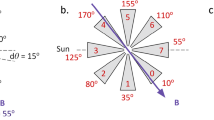Abstract
Quiet-time anisotropy data have been obtained by the HEOS-1 spacecraft between December 1968 and April 1970 using an 8-sector analysis of a Čerenkov telescope which has a threshold rigidity of about 1 GV for protons. Meridian and ecliptic plane scans were made. Data obtained at satellite altitudes greater than 20 Earth radii were selected and showed consistent evidence for a sunward radial streaming component of amplitude ~ 0.3% while the azimuthal component from the east showed an apparently significant variation from 0.6% at the start of the period to less than 0.2% at later times. Experimental effects are considered and eliminated as a spurious source of the anisotropy.
As there is no comparable radial streaming at neutron monitor rigidities this effect would appear to be largely confined to particles in the rigidity range 1 to 5 GV. Radial streaming of this amplitude is incompatible with the Urch-Gleeson numerical solutions of the Fokker-Planck transport equation under spherical symmetry. Also no significant correlation of the anisotropy with the interplanetary sector structure was found. A probable explanation lies in a symmetrical falling off-ecliptic gradient associated with the zones of maximum solar activity.
Similar content being viewed by others
References
Balogh, A., Dyer, C. S., Engel, A. R., Hynds, R. J., and Quenby, J. J.: 1971, 12th Intern. Conf. on Cosmic Rays, Hobart 5, 1819.
Engel, A. R.: 1970, in V. Manno and D. E. Page (eds.), Intercorrelated Satellite Observations Related to Solar Events, Reidel, Dordrecht, Holland, p. 478.
Hashim, A. and Bercovitch, M.: 1971, 12th Intern. Cosmic Ray Conf., Hobart 2, 596.
Hatton, C. J. and Barker, M. C.: 1971, 12th Intern. Cosmic Ray Conf., Hobart 2, 603.
Jokipii, J. R.: 1966, Astrophys. J. 146, 480.
Lietti, B. and Quenby, J. J.: 1968, Can. J. Phys. 46, S942.
Lockwood, J. A., Lezniak, J. A., and Webber, W. R.: 1972, J. Geophys. Res. 77, 4839.
Parker, E. R: 1967, Planetary Space Sci. 15, 1722.
Pomerantz, M. A. and Duggal, S. P.: 1971, Space Sci. Rev. 12, 75.
Quenby, J. J. and Hashim, A.: 1969, Planetary Space Sci. 17, 1121.
Rao, U. R., McCracken, K. G., and Bartley, W. C.: 1967, J. Geophys. Res. 72, 4343.
Rygg, T. A. and Earl, J. A.: 1971, J. Geophys. Res. 76, 7445.
Sandström, A. E.: 1965, Cosmic Ray Physics, North-Holland.
Steljes, J. F.: 1970, AECL-3658, Atomic Energy of Canada Ltd., Chalk River, Ontario.
Urch, I. H. and Gleeson, L. J.: 1972, Astrophys. Space Sci. 16, 55.
Webber, W. R.: 1967, Handbuch der Physik XLVI/2, 181.
Wilcox, J. M. and Colburn, D. S.: 1972, J. Geophys. Res. 77, 751.
Author information
Authors and Affiliations
Additional information
NAS/NRC Resident Research Associate, Goddard Space Flight Center, Greenbelt, MD 20771, U.S.A.
Rights and permissions
About this article
Cite this article
Dyer, C.S., Engel, A.R., Quenby, J.J. et al. Observation and explanation of a 0.3% sunward radial streaming of 1 to 5 GV cosmic radiation. Sol Phys 39, 243–259 (1974). https://doi.org/10.1007/BF00154985
Received:
Issue Date:
DOI: https://doi.org/10.1007/BF00154985




